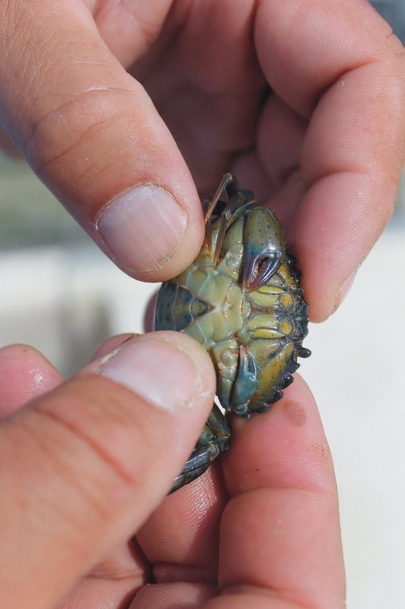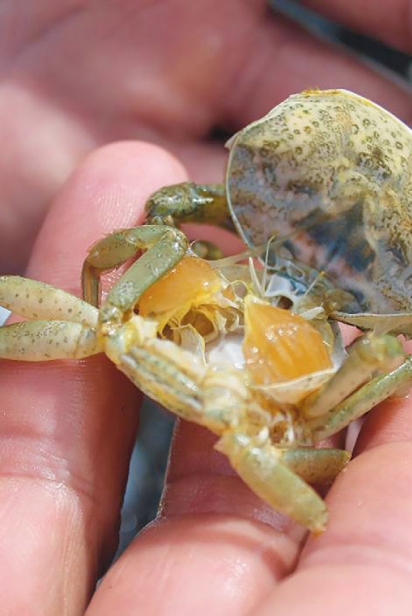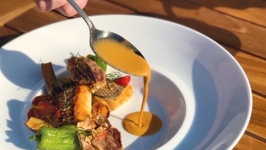Recipe for Disaster: The European Green Crab
The story of the little-known invasion threatening an entire New England ecosystem, and the struggle of local experts, fishermen and restaurants to work toward a solution.
I first became interested in green crabs last July at the Woods Hole Film Festival when I watched a thought-provoking documentary called Recipe for Disaster: Green Crabs on Great Marsh.
The film tells the story of how the European green crab is threatening an entire New England ecosystem. “If we did nothing, they would overwhelm the estuaries completely,” said Roger Warner, Founder of Green Crab R&D Project (greencrab.org).
The 2014 was a peak year for green crabs. As the Gulf of Maine has warmed, the population of green crabs that has been here for decades exploded. The European green crab was first discovered on the east coast of North America in the early 1800s. They are native to Europe and were introduced to North America via shipping.
Green crabs are small and aggressive. “One adult green crab can eat as many as forty half-inch clams in a day,” said Scott Lapreste, Shellfish Constable in Ipswich, Massachusetts. One female can lay 185,000 eggs.
“Everybody is in favor of doing something about green crabs,” said Warner. “It’s not why or how are you going to do it, but rather, what will it take?”
In the days following the film, when I talked about what I’d learned to friends, family and even new acquaintances, I was struck by how few people had ever even heard of green crabs, and even fewer knew they were an edible food source. “Do you mean blue crabs?” a friend asked. “I’ve seen green crabs, but I didn’t know you could eat them,” another friend said.
How can we address a problem that is threatening our ecosystem if there are so few who know about it? I wanted to know more, so I called the film’s director, Nubar Alexanian of Walker Creek Media, at his Gloucester, Massachusetts studio. He explained that, driven by the rising temperatures in the Gulf of Maine, billions of green crabs have overrun the abundant natural marshes on coastal New England, decimating the populations of clams, scallops, mussels and eelgrass that birds and fish depend on to survive. He goes on to say, “the damage caused by green crabs has local residents and experts rushing to avert irreparable destruction.”
Current approaches to solving the green crab problem include transplanting eelgrass and paying fisherman to trap the crabs for compost. When the crabs move into an area and destroy all the eel grass, they threaten the environment for fin fish. A third approach is to put effort into research and development for eating the green crabs—which involves understanding the molting process and also using the eggs.
I asked Mr. Alexanian where his interest in green crabs began. He has spent 40 years in the Great Marsh, often fly fishing. Great Marsh comprises much of the northeastern half of Essex County, Massachusetts, and touches the towns and cities of Essex, Gloucester, Newburyport, Newbury, Rowley, Ipswich and Salisbury.
What does the green crab problem look like on Cape Cod? Are any local restaurants serving green crabs? I went out to Chatham to meet with Anthony Cole, Executive Chef of Chatham Bars Inn, and Chef de Cuisine, Christopher Jenkins, because I heard they were using green crabs on their menu. In the fall of 2018, Chatham Bars Inn began incorporating green crabs into some of their sauces and soups. Jenkins said customers were curious about green crabs when they saw it appear as a menu item.
Cole suggested I talk with Jamie Bassett, a commercial fisherman and founder/owner of Green Crab Nation (greencrabnation.com). Bassett is the largest local supplier of green crabs and is a great resource when it comes to developing the use of green crabs as a local food source.
I met Jamie Bassett near the dock of Ryder’s Cove Landing off Route 28 in Chatham to witness the process of trapping green crabs. We went to a small dock in the cove where he ties crates to what he calls a “rickety dock” where he stores green crabs he caught the day before.
As we made our way into the cove Bassett told me about a trip he took to Venice, Italy in 2011 to learn about the commercial use of green crabs. He explained the Venetians have been serving green crabs for centuries, and he wanted to discover what he could learn about practices we could adopt on Cape Cod.
When we arrived at the dock Bassett logged the day, time and weather conditions before checking to see if any crabs had molted since the day before. Molting is when a crab loses its outer shell and becomes soft. When the crabs molt, they are ready to be cooked and eaten. By keeping a log, Bassett learns about the conditions under which the crabs molt.
He explained that once soft, the green crabs are good deep fried, served over linguini, or used as stock in soups and sauces. You can dredge a molted green crab in batter, then deep-fry it and it tastes a little sweeter. In Venice the roe and tomalley of the female green crab is a delicacy known as Masinette.
Outside of Venice, however, the green crab has primarily been considered a destructive nuisance. Here in New England Alexanian’s film and the efforts of local fisherman like Jamie Bassett of Green Crab Nation seek to change that by first increasing our awareness, then finding ways to use the crabs as a reliable and viable food source.







